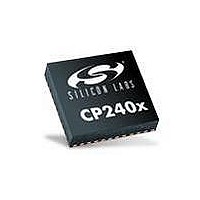CP2401-GQ Silicon Laboratories Inc, CP2401-GQ Datasheet - Page 71

CP2401-GQ
Manufacturer Part Number
CP2401-GQ
Description
IC LCD DRIVER 48TQFP
Manufacturer
Silicon Laboratories Inc
Specifications of CP2401-GQ
Package / Case
48-TQFP, 48-VQFP
Display Type
LCD
Configuration
128 Segment
Interface
I²C, SMBus
Current - Supply
620µA
Voltage - Supply
1.8 V ~ 3.6 V
Operating Temperature
-40°C ~ 85°C
Mounting Type
Surface Mount
Data Ram Size
256 B
Interface Type
I2C, SMBus
Maximum Clock Frequency
25 MHz
Number Of Timers
2
Operating Supply Voltage
1.8 V to 3.6 V
Maximum Operating Temperature
+ 85 C
Mounting Style
SMD/SMT
Minimum Operating Temperature
- 40 C
Lead Free Status / RoHS Status
Lead free / RoHS Compliant
Digits Or Characters
-
Lead Free Status / Rohs Status
Lead free / RoHS Compliant
Other names
336-1860
Available stocks
Company
Part Number
Manufacturer
Quantity
Price
Company:
Part Number:
CP2401-GQ
Manufacturer:
Silicon Laboratories Inc
Quantity:
10 000
Part Number:
CP2401-GQ
Manufacturer:
SILICON LABS/芯科
Quantity:
20 000
Company:
Part Number:
CP2401-GQR
Manufacturer:
Silicon Laboratories Inc
Quantity:
10 000
11.1.2. Using RTCADR and RTCDAT to Access SmaRTClock Internal Registers
The SmaRTClock internal registers can be read and written using RTCADR and RTCDAT. The RTCADR register
selects the SmaRTClock internal register that will be targeted by subsequent reads or writes.
A SmaRTClock Write operation is initiated by writing to the RTCDAT register. Below is an example of writing to a
SmaRTClock internal register.
A SmaRTClock Read operation is initiated by setting the SmaRTClock Interface Busy bit. This transfers the
contents of the internal register selected by RTCADR to RTCDAT. The transferred data will remain in RTCDAT until
the next read or write operation. Below is an example of reading a SmaRTClock internal register.
11.1.3. SmaRTClock Interface Autoread Feature
When Autoread is enabled, each read from RTCDAT initiates the next indirect read operation on the SmaRTClock
internal register selected by RTCADR. Software should set the BUSY bit once at the beginning of each series of
consecutive reads. Software must check if the SmaRTClock Interface is busy prior to reading RTCDAT. Autoread is
enabled by setting AUTORD (RTCADR.6) to logic 1.
11.1.4. RTCADR Autoincrement Feature
For ease of reading and writing the 32-bit CAPTURE and ALARM values, RTCADR automatically increments after
each read or write to a CAPTUREn or ALARMn register. This speeds up the process of setting an alarm or reading
the current SmaRTClock timer value by allowing all 4 CAPTURE or ALARM registers to be read or written in a
single block write. Autoincrement is always enabled.
Notes: Autoincrement should only be used with block reads/writes. When using single-byte reads/writes, RTCADR must be
written before each data read or write.
When using SMBus to perform a block read/write, the RTCADR register must be written using the REGSET command.
1. Write 0x05 to RTCADR. This selects the internal RTC0CN register at SmaRTClock Address 0x05.
2. Write 0x00 to RTCDAT. This operation writes 0x00 to the internal RTC0CN register.
1. Write 0x05 to RTCADR. This selects the internal RTC0CN register at SmaRTClock Address 0x05.
2. Write 1 to BUSY. This initiates the transfer of data from RTC0CN to RTCDAT. Note: Step 1 and Step 2
3. Read data from RTCDAT. This data is a copy of the RTC0CN register.
may be combined into a single write.
Rev. 1.0
CP2400/1/2/3
71












